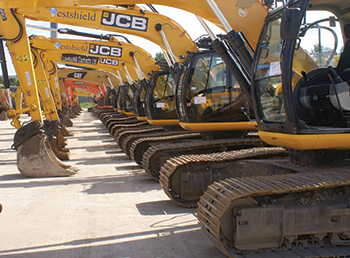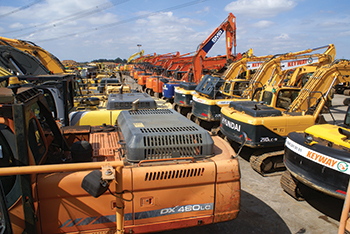Top tips for buying at auctions
DEREK BLEAKLEY, general manager, Dubai, for auctions specialist Euro Auctions provides 10 ‘top tips’ for buying an excavator at auction to help prospective buyers ensure they carry out all the checks and end up with a good buy.
01 March 2020
Buying an excavator at auction, where there is typically an array of models and types to choose from, is an exciting prospect. However, how do you pick the best machine? How do you find that perfect excavator? Here are 10 top tips that are designed to help make the decision:
1 – History: Consider the history of the machine as much as the hours. Has the machine had one or two ‘careful’ owners in its life? If the excavator is three years old but is an ex-rental machine, then it could have had a lot of users in its life. On the plus side, ex-rental machines from large hire fleets are serviced well. Look at the service record, and the general condition of the machine should tell if it’s had a hard life.
2 – Slew ring: Check the slew ring for play or movement that is not a normal part of its operations. When the hydraulic excavator housing is rotated, it should be tight and smooth, with no play or abnormal movement. Check all connection points, especially between the stick, boom and bucket. Check all bushings and pins for loose play, as looseness in the connection points results in less accuracy. If the slew ring is damaged, don’t buy the machine, as it’s one of the most expensive parts to replace.
 |
|
EuroAuctions premises in Jebel Ali, Dubai. |
3 – Exterior condition: The exterior of the machine should be checked for dents, cracks and bends. The boom and stick, which have been heavily used, may experience warps and bends. This typically results in the need to replace the damaged part, which can be expensive. Dents on the stick or other parts of the machine may be a sign that the machine was misused by previous owners.
Records should be closely examined to ensure the machine was not used as a rental, as rented machines have higher rates of misuse by operators. Cracks are a definitive sign of degeneration or misuse and most likely mean the affected parts will need to be replaced soon to avoid a larger problem developing.
4 – Hydraulics: Leaks in the hydraulics can be a sign of misuse or degeneration. All cylinders, hoses and lines should be thoroughly examined. The hydraulic pump compartment should be examined for any type of leaks, as well as the swing bearing and slew ring.
5 – Hour meter: Check the hour meter, to authenticate the number of hours the machine has been in operation. If the hour meter is not working correctly, or if there is any reason to question the validity of the reading, the control pedals can be checked.
6 – Bucket and attachments: Excessive wear on the bucket teeth is indicative of a reduction in digging efficiency and could be a sign that the bucket needs to be replaced. The bucket will most likely still be operational with these defects, but at a reduced efficiency. A good machine may also include a good set of buckets and other attachments.
7 – Parts and maintenance: The model of the excavator should be researched to ensure that parts are readily available and can be purchased. For mainstream brands, this is never a problem but for new imports be careful, as manufacturer support and maintenance may be required in the future.
 |
|
On tracked machines, check individual metal plate tracks and see if they are broken or have signs of wear. |
8 – Tyres and tracks: The current condition of the tyres on wheeled excavators should be examined and if possible, the number of hours on the tyres should be determined. Most excavator tyres have an expected life of 5,000 hours. Tyres cut up badly may indicate a machine that has been used in a quarry, whilst good tyres may indicate road use.
On tracked machines, check individual metal plate tracks and see if they are broken or have signs of wear. Check the sprockets and rollers and if these need replacement, then the total cost of this used excavator may go higher. Check the roller metal frame of the excavator, looking for signs of cracks or repairs.
9 – Price: Excavators hold their value well and whilst a lot of emphasis is on the recorded hours, additional factors may come into play when determining the value of used excavators. This includes: the year the model was made, which attachments are included in the sale, overall condition, service records, as well as the demands of the global market.
10 – Start the engines! Start the machine, getting it up to operating temperature. Listen for unusual engine noises and check for excessive exhaust smoke. Open the engine compartment to check for blow-by. Pull out the dipstick and feel for pressure. If excessive, it may mean there could be some power issues.
Check for oil leaks in the valve covers, seals and oil pan. Examine all fluid and coolant levels, noting the oil condition and checking for water in the engine oil. Note the colour of the antifreeze and make sure all filters show current dates and are in good condition.
Make several simulated digging cycles with the boom, stick and bucket. Swing the boom left and right, extending the stick and opening and closing the bucket. Look for any looseness in the pins and bushings or coupler. Operate the blade up and down. Raise the front of the machine with the blade. Swing the upper body to the left and right, again checking for hesitations. Brake during each rotation and note the response.
Run the machine in forward and in reverse and turn left and right with the tracks. Moving the boom to one side and using the bucket as an anchoring point, lift the machine and run the elevated track, checking for any cuts, missing chunks or dry rot in the rubber. Make sure it rotates freely. Repeat on the other side.
Check the operation of all controls and gauges, operate the air-conditioning, note any glass, mirror or door latch problems. Finally, check window wipers and external lights.
Exhausted? You will be, but if you are looking for a top machine you must put in the effort to find out exactly what you are bidding on or buying. Follow these tips and you won’t be going home with a bad deal.
For further guidance on buying a used excavator or to find out what machines are coming up for auction in the near future, visit www.EuroAuctions.com
- Top tips for buying at auctions
- Hitachi to equip excavators with ConSite solution
- What to consider when buying a new machine
- Bobcat control system wins Samoter award



